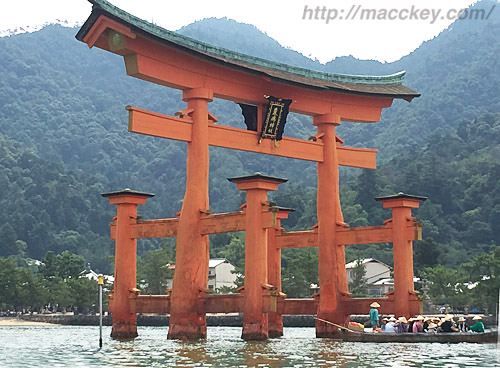
Miyajima and Itsukushima Shrine is a World Heritage site and one of the three most scenic spots in Japan. Its famous symbol is the vermilion-lacquered Otorii (Grand Gate) floating on the sea.
It is well-known not only to those who have been to Miyajima but also to those who have never been to Miyajima.
This 16.6-meter-high Otorii is clearly visible from the ferry, and when you cross over to Miyajima, you are truly overwhelmed by its grandeur.
The damage became so severe that restoration work began in June 2019, and it was not visible for about three and a half years, but the work was successfully completed last December 2022, and the sight of it can be seen again.
We hope that many people will visit the museum!
And you can enjoy the Otorii even more up close and personal on the “rokaibune,” a sightseeing oar boat introduced in this article.
The boat is a small boat that rows slowly and allows you to pass under the Otorii Gate while the boatman explains the various aspects of the gate. It is a strange and moving experience to look up at the Otorii, which you have only seen from afar, from directly below as you pass through it.
Here is a video of my previous experience of riding the oar boat, my story, and a summary of the fees and other details.
What is an oarboat?
It’s faster if you take a look. (*^o^*)
I will post the video I took at that time. It will give you a feel of the atmosphere! Please enjoy it and you will also hear the voice of the person explaining it.
A small boat made of wood, about 12 meters long. The capacity of the boat is about 20 passengers. There are two rowers, one in front and one behind, who paddle the boat with oars and oars, and one person who acts as a guide, for a total of three passengers.
There are no reservations, and tickets are purchased on the spot. When it is crowded, there is a line, but I don’t think it is very crowded.
.
Experience the oar boat (rokaibune) for yourself!
Yes, I did. I tried it myself.
The boat has seating areas on both sides, lined with plastic cushions. You sit on them, and I heard that these cushions serve as floatation rings in case of emergency. I see.
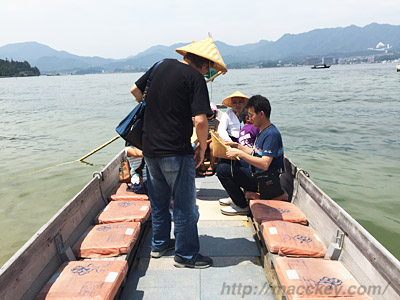
In addition, life jackets are also provided, so those who are concerned can wear them. In fact, the boat did not capsize, although it was a little bumpy during the trip (laugh).
(laugh) There have been no accidents in the past, and I think it is safe to say that it is safe. (^_^;
First of all, you are lent a triangular hat made of woven bamboo if you wish. It was hot and everyone, including myself, borrowed one and put it on because I felt better with it on.
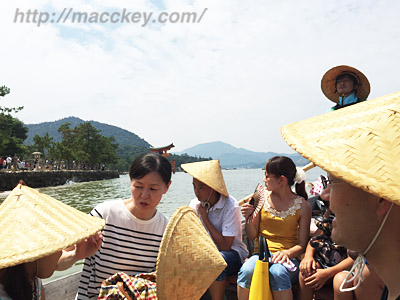
The boat slowly sets sail as the rowers start rowing with oars in front and behind. Then the person in charge of explaining the boat will talk about the history of Itsukushima Shrine and the Otorii, the materials used for the torii, and many other things following the cautionary tale.
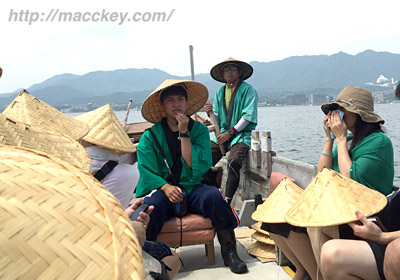
In 7-8 minutes, you will arrive right next to the torii gate. Pass directly under the gate. Then turn around and go through again. On the way to Itsukushima Shrine, you can pay your respects from the top of the boat, and a person in charge of explaining the tour will take pictures of you.
The boat will then slowly return to the boarding area.
It is a short 20-minute cruise, but it is a rare experience to see the Otorii from directly below, and it is very moving. (At low tide, you can walk to the Otorii and view it from directly below, but seeing it from a boat is quite different.)
) The view of the Otorii from the island is beautiful, but you should definitely try the experience of going through the Otorii on an oar boat! I recommend it!
Period of operation and other details
Let me summarize the details of the oar boat.
- Period of operation
-
Around March to November
- Travel time
-
Approx. 20 min.
- Operating hours
-
Irregular. The boat is operated for 2 to 3 hours a day from 10:00 to 15:00, mainly at high tide. The operation is subject to change depending on the weather, tide level, and other factors on the day, and may be cancelled if the weather becomes unfavorable.
- Fees
-
Adults: 1,000 yen, Elementary school students from 4 years old: 500 yen
- Reservation
-
The operation itself depends on the tide and weather, and there are no reservations. If the boat is running, you can buy tickets on the spot and board in order.
- Boarding Location
-
From Miyajima Pier, walk in the direction of Itsukushima Shrine for about 7 to 8 minutes. It is near the stone torii (gateway) to the shrine.
- Operating company
-
Miyajima Pleasure Cruise Co.
- Home page
-
http://yu-ran.com/rokaipage.html
Please check the website for the latest information.
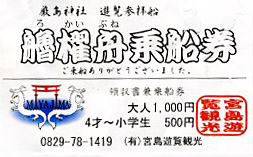

It is also recommended to check the time of high tide!
To take the oar boat, you need to know the high tide time near Miyajima and cross to Miyajima accordingly. The Miyajima Tourist Association’s annual tide table is a good source for high tide times.
(The chart is for Hiroshima Port. Itsukushima Port is said to be slightly earlier than this, but the same can be used)
⇒ Annual Tide Table of Miyajima Tourist Association
It would be best if you check the Miyajima sightseeing page and this page together!
At low tide, there is another pleasure!
As I mentioned in another article, at low tide you can go down to the beach and walk to the torii.
This is also one of the pleasures, so I would like visitors to experience both the oar boat and the Otorii gate, which can be touched on foot.
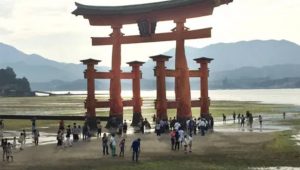
Mini-knowledge of the Otorii
- The height is about 16.6 m, the length of the wing is 24.2 m, the circumference of the main pillar is 9.9 m, and the total weight is about 60 tons.
- It is said that it was first built around 1168 (Nin’an 3) by Taira no Kiyomori, but details are not known. The current one is the eighth generation, and was rebuilt in 1875 (Meiji 8). Recently, it was repainted in April 2003.
- The plaque reads “Itsukushima Shrine” on the offshore side and “Itsukushima Shrine” on the island side.
The moon and the sun are decorated on both ends of the shade tree. It is said that the person who sees them will live 30 years longer, although they cannot be seen unless one approaches the shrine by boat. - The torii gate is not buried deep in the ground, but stands on its own weight. The bottom of the roof is a box with several tons of stones in it, which act as weights. It is kind of amazing.
I hope you too will enjoy oar boats!
Click here to read articles related to Miyajima and Itsukushima Shrine on this blog.
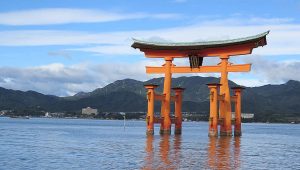

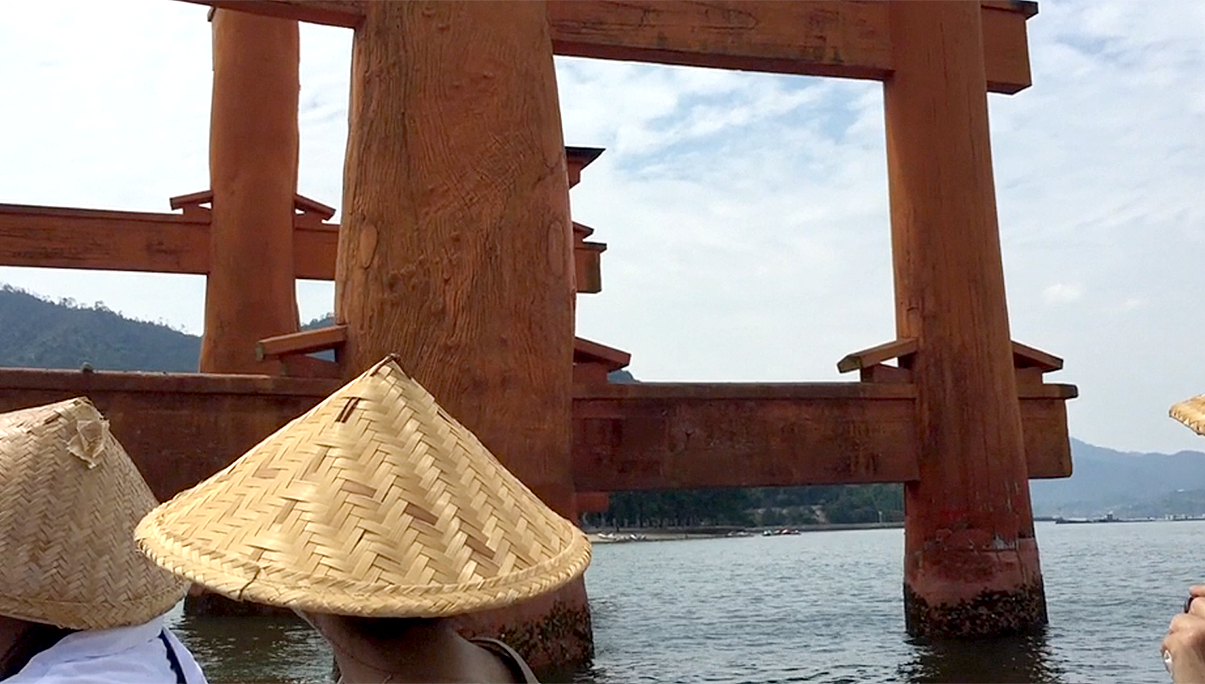
Comments